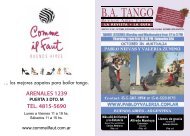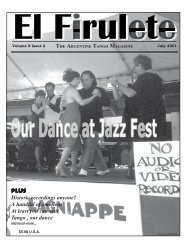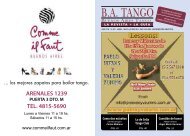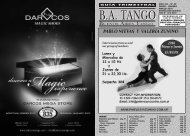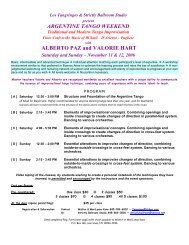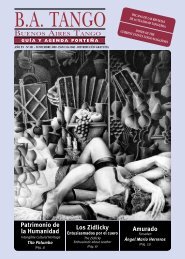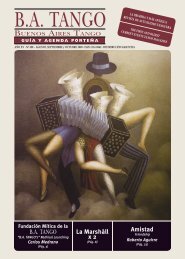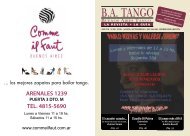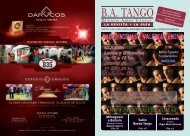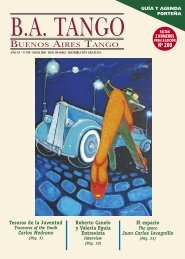Liturgia de repetición en el tango Diana Braceras - Planet Tango
Liturgia de repetición en el tango Diana Braceras - Planet Tango
Liturgia de repetición en el tango Diana Braceras - Planet Tango
Create successful ePaper yourself
Turn your PDF publications into a flip-book with our unique Google optimized e-Paper software.
TEN YEARS AGO Continued from page 17<br />
Exactly t<strong>en</strong> years ago, in<br />
July 1999, we published the<br />
issue No.100 of this magazine,<br />
and now, next August,<br />
we’ll have another c<strong>el</strong>ebration<br />
wh<strong>en</strong> we’ll give you the issue<br />
No. 200: another extraordinary<br />
issue, like the one appearing t<strong>en</strong><br />
years ago. Th<strong>en</strong>, the cover was<br />
a painting by Maestro RICARDO<br />
CARPANI, a prestigious plastic<br />
artist, who gave testimony of<br />
<strong>tango</strong> and the Arg<strong>en</strong>tine society.<br />
The issue No. 99 was illustrated<br />
by another outstanding Maestro,<br />
ALDO SEVERI.<br />
A great number of high quality<br />
journalistic articles were<br />
published. Interviews with JOSÉ<br />
“PEPE” LIBERTELLA, one of the<br />
bandonionists who created the<br />
Sexteto <strong>Tango</strong> (by Luis Tarantino), the bandonionist, pianist, composer<br />
and conductor JULIÁN PLAZA (by Luis Tarantino), the dancer and choreographer<br />
CARLOS RIVAROLA (by Diego Llumá, courtesy of Balletin Dance<br />
magazine), the young bandonionist and composer GABRIEL RIVANO (by<br />
Luis Tarantino), the members of the MOLINA-CABELLO Quintet (by Marina<br />
González), lyricist and writer GLORIA MARCÓ (by Marina González.)<br />
The Photo Gallery showed, among others, RUBÉN PEÑA and SUZANNE<br />
RASIUNAS, ALICIA GÓMEZ and GUILLERMO VINELLI, MARCOS CATTÁNEO,<br />
POCHO FANTONI and ALBERTO DÍAZ, MARÍA TELMA (POLCAN) and TITO<br />
(VILLA), SUNSHINE and JORGE COLOMBO, bandonionist PABLO GRECO,<br />
singers MABEL AGUILAR and GLADYS MANZI, GERARDO PORTALEA, RAÚL<br />
RICARDO PORTALEA, OSCAR MARCELO VARGAS and SUSANA <strong>de</strong> VARGAS,<br />
CARLOS MEDRANO, CARLOS MONTAÑA, NORMA MINERVINO and ESTER<br />
DECARLO, FABIÁN PERALTA and SILVIA FUENTES, NINA (BALBUENA) and<br />
LUIS CÓRDOBA, and all the advertisers who ma<strong>de</strong> it possible for this<br />
magazine to reach issue Nº 100 appeared in an vast series.<br />
JOSÉ GARÓFALO wrote the chronicles of the shows “S<strong>en</strong>timi<strong>en</strong>to<br />
<strong>Tango</strong> (<strong>Tango</strong> Fe<strong>el</strong>ing)”, directed by JUAN CARLOS COPES, with a cast<br />
of dancers, singers and musicians; “Amores <strong>de</strong> <strong>Tango</strong> (<strong>Tango</strong> Loves)”,<br />
performed and directed by the singers MARIANA MARTÍNEZ VIEYRA and<br />
MATÍAS HACKER; “Una C<strong>el</strong>ebración – <strong>Tango</strong> (A C<strong>el</strong>ebration – <strong>Tango</strong>)”<br />
performed and directed by the dancers GIULIANA ROSSETTI and LEO-<br />
NARDO CUELLO.<br />
A controversy arose in r<strong>el</strong>ation to <strong>de</strong>clarations ma<strong>de</strong> by some dancers<br />
who consi<strong>de</strong>red thems<strong>el</strong>ves MADONNA’s <strong>tango</strong> teachers; these controversies<br />
were collected in a sound article by TITO PALUMBO. Within<br />
the same tone of criticism, he wrote about the shows where the dance<br />
becomes a circus acrobatics, and worst of all, this is the part which the<br />
public applauds the most.<br />
Story t<strong>el</strong>ler GRACIELA LÓPEZ –before she became the organizer of<br />
the milonga LA MILONGUITA– gave us a story called “Guy, for loving<br />
you so much.”<br />
We reviewed two records, one with the participation of violin player<br />
MAURICIO MARCELLI, and another, by singer and guitar player HUGO<br />
RUADES. Pictures by LILIANA LIFE, CARLOS PÉREZ VILLAMIL, ALDO<br />
SEVERI, LYDIA CHUSTER, EDMUNDO LABOURDETTE and LIRIA MIYAKAWA<br />
were exhibited in differ<strong>en</strong>t galleries. We informed the <strong>de</strong>cease of<br />
pianist, composer, arranger, conductor and union executive FULVIO<br />
SALAMANCA.<br />
OSCAR PUELLA organized a milonga in CLUB HURACÁN’s cafeteria<br />
on Saturdays, with CARLOS FIGUERAS as the DJ; LUIS CÓRDOBA<br />
and NINA BALBUENA op<strong>en</strong>ed a milonga in CLUB MALENA, near Villa<br />
<strong>de</strong>l Parque’s railroad station, on Saturdays, in the same place where<br />
SUZUKI AVELLANEDA ran a milonga on Mondays, and HÉCTOR DÍAZ with<br />
CLAUDIA CHUKAIR another one on Wednesdays; ROBERTO CONTRERAS<br />
and MARÍA LEMOS brought a proposal in CLUB ATLÉTICO PLATENSE on<br />
Sundays, with bad luck, because in the edition of the second fortnight<br />
of June we were reporting crime news that happ<strong>en</strong>ed in this place on<br />
the 5th; the matter was an assault committed by five strongly armed<br />
young m<strong>en</strong> who stole the values of the people that was there – the<br />
insecurity in the city is not only a curr<strong>en</strong>t issue. Other new milongas<br />
were offered by OMAR VIOLA in HORSE STEAM, in the neighborhood of<br />
La Boca; GRACIELA and CARLOS MATERA in the SALÓN MORENO; and<br />
LAURA (GRINBANK) associated with VILMA MARTÍNEZ in the CONFITERÍA<br />
NEGRONE in the neighborhood of Recoleta.<br />
TRANSCENDENTAL EXPERIENCE Continued from page 3<br />
THE LITURGY OF REPETITION IN THE TANGO<br />
By DIANA BRACERAS (1)<br />
One of the most important<br />
functions of the rite is<br />
the or<strong>de</strong>ring of r<strong>el</strong>ations<br />
betwe<strong>en</strong> the profane world and<br />
the sacred world.<br />
The rite, un<strong>de</strong>rstood as a liturgy<br />
of repetition, basically structures<br />
the myth, a formula that<br />
tries to narrate something that is<br />
impossible to know. Within that<br />
framework, the rite is a staging of<br />
the r<strong>el</strong>ations with what is unattainable<br />
or what is inevitably lost:<br />
the dim<strong>en</strong>sion of the sacred world,<br />
fascinating and dangerous at the<br />
same time. The tanguero embrace<br />
is a place for the ceremony of the<br />
mysteriously disturbing <strong>en</strong>counter<br />
betwe<strong>en</strong> a man and a woman.<br />
On the Milonga<br />
The physical <strong>en</strong>vironm<strong>en</strong>t<br />
of a milonga, <strong>tango</strong> temple that<br />
attracts the faithful to the ceremony,<br />
is invested with an intangible<br />
halo which perfects a mixture<br />
of possessed sound, discreet<br />
lights and a framework of little<br />
tables where the participants seat<br />
their dancing expectations; they<br />
are also discreetly sociable, the<br />
focus of att<strong>en</strong>tion of the ev<strong>en</strong>ts<br />
will be the dance floor. In fact,<br />
fri<strong>en</strong>ds of murmurs and the dialog<br />
of looks, the m<strong>en</strong> get into the<br />
temple with leather sole shoes;<br />
the wom<strong>en</strong>, in he<strong>el</strong>s, like uneasy<br />
horses that try the ground, will<br />
follow the rhythm of music, with<br />
their feet next to the legs of<br />
their little table, until a flattering<br />
nod marks the starting shot.<br />
The transformation of the<br />
tanguero <strong>en</strong>counter into a ritual<br />
requires several types of repetitions:<br />
• Three or four successive<br />
rhythmical compositions of the<br />
same kind form a ‘tanda’, <strong>tango</strong>,<br />
milonga or waltz.<br />
• A musical curtain indicates the<br />
<strong>en</strong>d of every ‘tanda’. It is not<br />
danced.<br />
• Choosing the partner through<br />
looking. He nods, she accepts in<br />
an almost unnoticed way. They<br />
individually walk the distance<br />
that separates them and meet at<br />
the edge of the dance floor.<br />
• The man holds the woman in<br />
a typical embrace which keeps<br />
the clos<strong>en</strong>ess and the distance<br />
betwe<strong>en</strong> the bodies allowing a<br />
subtle dialog in a perman<strong>en</strong>t<br />
face-to-face position.<br />
• The man chooses how to move,<br />
in a strict anti-clockwise direction,<br />
in an imaginary circle which<br />
is collectiv<strong>el</strong>y followed by the<br />
dancers.<br />
• The ‘tanda’ is danced with the<br />
same partner. Wh<strong>en</strong> it finishes,<br />
the g<strong>en</strong>tleman will walk the lady<br />
towards her table, and they will<br />
both thank each other for the pleasure<br />
of having danced together.<br />
• The last song will be The<br />
Cumparsita by GERARDO MATOS<br />
RODRÍGUEZ. <strong>Tango</strong> which overuses<br />
repetition in its<strong>el</strong>f, since<br />
each instrum<strong>en</strong>t has the chance<br />
to let its virtuosity be list<strong>en</strong>ed to<br />
in the musical repetition of the<br />
composition, so it lasts longer<br />
than the classic <strong>tango</strong>s from the<br />
same time.<br />
Outsi<strong>de</strong> the milonga, each one<br />
recovers their own story, age, rush<br />
and tiredness; their loves and lack<br />
of love, their lon<strong>el</strong>iness and that<br />
human need to be an ordinary citiz<strong>en</strong><br />
of the world. That one…who<br />
doesn’t know how to manage with<br />
his partner and his lon<strong>el</strong>iness on<br />
the dance floor of life.<br />
The <strong>Tango</strong> dance, sustained<br />
by the s<strong>en</strong>sual embrace, offers<br />
a know-how about the g<strong>en</strong><strong>de</strong>r’s<br />
differ<strong>en</strong>ce, expressing in the<br />
aesthetics of the movem<strong>en</strong>t an<br />
un<strong>de</strong>rstanding without words…<br />
that the lyrics tragically refute.<br />
On Heroes and Tombs<br />
The Cumparsita, repeated in<br />
the same or differ<strong>en</strong>t orchestral<br />
versions, not s<strong>el</strong>dom, while the<br />
lights are turned on, showing that<br />
the milonga has <strong>en</strong><strong>de</strong>d, indicates<br />
–like the tw<strong>el</strong>ve strokes in the<br />
fairy tale– the reincorporation in<br />
the profane world, space which<br />
is necessarily <strong>de</strong>prived of the<br />
sacred world, and which inclu<strong>de</strong>s<br />
a change of shoes, some clothes,<br />
the paym<strong>en</strong>t and goodbyes. The<br />
poor go back to their poverty…<br />
the rich go back to their richness<br />
and GARDEL and VIRULAZO rest,<br />
immortal, until the next Milonga.<br />
The repetition of the paradigmatic<br />
gestures r<strong>en</strong>ews the fundam<strong>en</strong>tal<br />
<strong>tango</strong>, transports att<strong>en</strong>dants to an<br />
original time that repetition continuously<br />
transforms, remaining<br />
won<strong>de</strong>rfully unchanging.<br />
The physical place, before<br />
and after, coffee shop or nearby<br />
club, changes into a receptacle<br />
with a str<strong>en</strong>gth that transc<strong>en</strong>ds<br />
daily objects, acquiring a differ<strong>en</strong>t<br />
value: strange and intimate. The<br />
milonga is a place, out of place,<br />
in<strong>de</strong>p<strong>en</strong><strong>de</strong>nt from time, neither<br />
totally real nor imaginary, but<br />
paradoxical. The liturgy of repetition<br />
forms a legality of its own,<br />
collectiv<strong>el</strong>y sustained by each one<br />
and by the rest…those who first<br />
ma<strong>de</strong> the gestures, the creators.<br />
Each Milonga, while it lasts,<br />
becomes the ‘c<strong>en</strong>ter of the world’;<br />
each <strong>Tango</strong> will be the first one<br />
and every <strong>tango</strong> in the universe.<br />
(1) Member of the Board of the<br />
Biospheric Activities Foundation<br />
and the World Aca<strong>de</strong>my<br />
of Arts and Sci<strong>en</strong>ces. E-mail:<br />
bracerasdi@yahoo.com.ar<br />
TIM.BOS Suplem<strong>en</strong>to <strong>de</strong> B.A.TANGO - Bu<strong>en</strong>os Aires <strong>Tango</strong> • Junio-Julio 2009<br />
Página • 29



